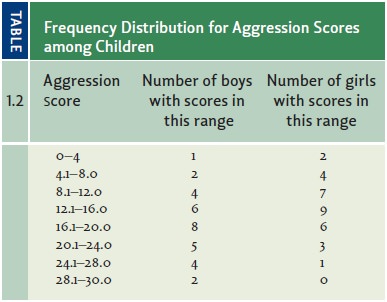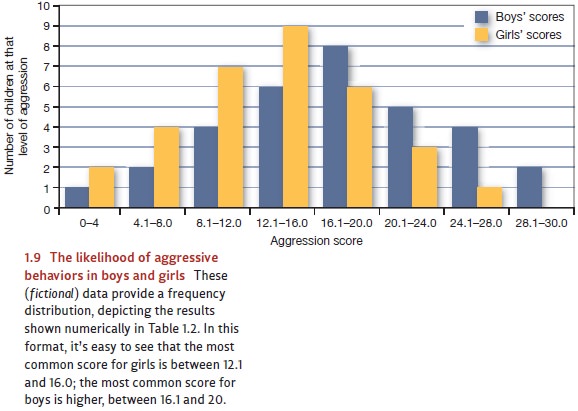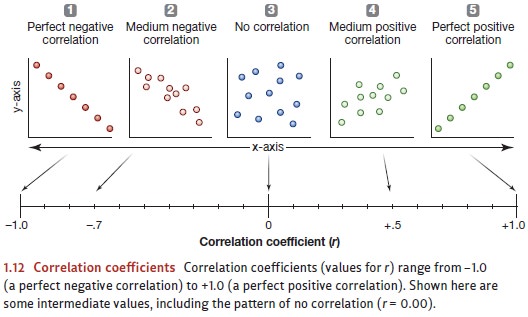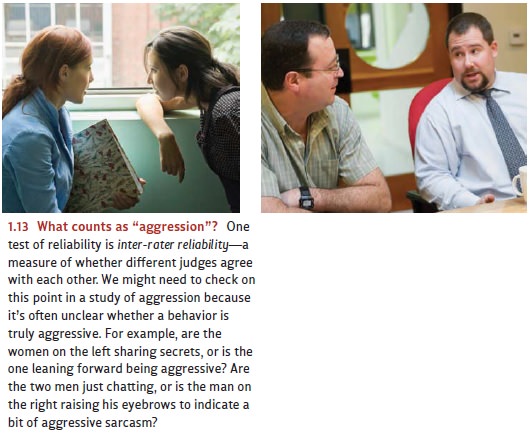Chapter: Psychology: Research Methods
Working With Data: Descriptive Statistics
Descriptive
Statistics
In Table 1.1, it’s difficult to
see any pattern at all. Some of the boys’ numbers are high, and some are lower;
the same is true for the girls. With the data in this format, it’s hard to see
anything beyond these general points. The pattern becomes obvious, however, if
we summarize these data in terms of a frequency
distribution (Table 1.2)—a table that lists how many scores fall into each
of the designated categories. The pattern is clearer still if we graph the
frequency distributions (Figure 1.9). Now we
most common scores (in these fictional data) are between 16.1 and 20 for
the boys andbetween 12.1 and 16.0 for the girls. As we move further and
furtherfrom these central
categories (looking either
at higher scores
orlower), the number of people at each level of aggression drops.



MEANS AND VARIABILITY
The distribution of scores in
Table 1.1 yields a graph in Figure 1.9 that is roughly bell shaped. In fact,
this shape is extremely common when we graph frequency distributions—whether
the graph shows the frequency of various heights among 8-year-olds, or the
frequency of going to the movies among college students, or the frequency of
particular test scores for a college exam. In each of these cases, there tends
to be a large number of moderate values and then fewer and fewer values as we
move away from the center.
To describe these curves, it’s
usually enough to specify just two attributes. First, we must locate the
curve’s center. This gives us a measure of the “average case” within the data
set—technically,

we’re looking for a measure of central tendency of these
data. The most common way of determining this average is to add up all the
scores and then divide that sum by the number of scores in the set; this
process yields the mean. But there
are other ways of defining the average. For example, sometimes it’s convenient
to refer to the median, which is the
score that separates the top 50% of the scores from the bottom 50%.
The second characteristic of a
frequency distribution is its variability,
which is a measure of how much the individual scores differ from one to the
next. A highly vari-able data set includes a wide range of values and yields a
broad, relatively flat frequency distribution like the one in Figure 1.10A. In
contrast, a data set with low variability has values more tightly clustered
together and yields a narrow, rather steep frequency distri-bution like the one
in Figure 1.10B.
We can measure the variability in a data set in several ways, but the most common is the standard deviation. To compute the standard deviation, we first locate the center of the data set—the mean. Next, for each data point, we ask: How far away is this point from the mean? We compute this distance by simply subtracting the value for that point from the mean, and the result is the deviation for that point—that is, how much the point “deviates” from the average case. We then pool the deviations for all the points in our data set, so that we know overall how much the data deviate from the mean. If the points tend to deviate from the mean by a lot, the standard deviation will have a large value— telling us that the data set is highly variable. If the points all tend to be close to the mean, the standard deviation will be small—and thus the variability is low.
CORRELATIONS
In describing
the data they
collect, investigators also find
it useful in
many cases to draw on another statistical measure: one
that examines correlations.
Returning to our example, imagine
that a researcher examines the data shown in Table 1.1 and wonders why some
boys are more aggressive than others, and likewise for girls. Could it just be
their age—so that, perhaps, the older children are better at con- trolling
themselves? To explore this possibility, the researcher might create a scatter plot ike the one shown in Figure
1.11. In this plot, each point represents one child; the child’s age determines
the horizontal position of the point within the graph, and his or her
aggression score determines the vertical position.

The pattern
in this scatter
plot suggests that
these two measurements—age and
aggression score—are linked, but in a
negative direction. Older children
(points to the
right on the scatter
plot) tend to
have lower aggression
scores (points lower down in the diagram). This relationship isn’t
perfect; if it were, all
the points would
fall on the
diagonal line shown in the figure. Still, the overall pattern of the
scat- ter plot indicates a relationship: If we know a child’s age, we can make
a reasonable prediction about her aggression level, and vice versa.
To assess data like these,
researchers usually rely on a meas- ure called the correlation coefficient, symbolized by the letter r. This
coefficient is always calculated on pairs of observations. In our example, the
pairs consist of each child’s age and his or her aggression score; but, of course, other
correlations involve other
pairings. Correlation coefficients can
take any value between +1.00 and –1.00 (Figure 1.12). In either of these
extreme cases, the correlation is perfect.
For the data
shown in Figure
1.11, a calculation
shows that r = –.60. This is a reasonably strong negative
correlation, but it’s obviously different from
–1.00, thus confirming
what we already
know—namely, that the
correlation between age and aggression score is not perfect.

Many of the relationships
psychologists study yield r values in
the ballpark of .40 to .60. These numbers reflect relationships strong enough
to produce an easily visible pat-tern in the data. But, at the same time, these
numbers indicate relationships that are far from perfect—so they certainly
allow room for exceptions. To use a concrete example, consider the correlation
between an individual’s height and his or her sex. When exam-ined
statistically, this relationship yields a value of r = +.43. The correlation is strong enough that we can easily
observe the pattern in everyday experience: With no coach-ing and no
calculations, people easily detect that men, overall, tend to be taller than
women. But, at the same time, we can easily think of exceptions to the overall
pattern— women who are tall or men who are short. This is the sort of
correlation psychologists work with all the time—strong enough to be
informative, yet still allowing relatively common exceptions.
Let’s be clear, though, that the
strength of a correlation—and therefore the consis-tency of the relationship
revealed by the correlation—is independent of the sign of the r value. A correlation of +.43 is no
stronger than a correlation of –.43, and correlationsof –1.00 and +1.00 both
reflect perfectly consistent relationships.
CORRELATION SANDRELIABILITY
In any science, researchers need
to have faith in their measurements: A physicist needs to be confident that her
accelerometer is properly calibrated; a chemist needs a reliable spectrometer.
Concerns about measurements are particularly salient in psychology, though,
because we often want to assess things that resist being precisely defined—
things like personality traits or mental abilities. So, how can we make sure
our measurements are trustworthy? The answer often involves correlations—and
this is one of several reasons that correlations are such an important research
tool.
Imagine that you step onto your
bathroom scale, and it shows that you’ve lost 3 pounds since last week. On
reflection, you might be puzzled by this; what about that huge piece of pie you
ate yesterday? For caution’s sake, you step back onto the scale and now it
gives you a different reading: You haven’t lost 3 pounds at all; you’ve gained
a pound. At that point, you’d probably realize you can’t trust your scale; you
need one that’s more reliable.
This example suggests one way we
can evaluate a measure: by examining its reliability—an
assessment of howconsistentthe
measure is in its results, and one pro-cedure for assessing reliability follows
exactly the sequence you used with the bathroom scale: You took the measure
once, let some time pass, and then took the same measure again. If the measure
is reliable, then we should find a correlation between these obser-vations.
Specifically, this correlation will give us an assessment of the measure’s test-retest reliability.
A different aspect of reliability
came up in our earlier discussion: In measuring aggres-sion, we might worry
that a gesture or a remark that seems aggressive to one observer may not seem
that way to someone else (Figure 1.13). We thus need to guard against the
possibility that our data are idiosyncratic—merely reflecting what one person
regards as aggressive. To deal with this concern, we suggested that we might
have a panel of judges observe the behaviors in question and that we’d trust
the data only if the judges agree with each other reasonably well. This
procedure relies on a different type of reliability, called inter-rater reliability, that’s calculated
roughly as the correlation between Judge 1’s ratings and Judge 2’s ratings,
between Judge 2’s ratings and Judge 3’s, and so on.

VALIDITY OF AMEASURE
Imagine that no matter who steps
on your bathroom scale, it always shows a weight of 137 pounds. This scale
would be quite reliable—but it would also be worthless, and so clearly we need
more than reliability. We also need our dependent variable to measure what we
intend it to measure. Likewise, if our panel of judges agrees, perhaps they’re
all being misled in the same way. Maybe the judges are really focusing on how
cute the var-ious boys and girls in the study are, so they’re heavily biased by
the cuteness when they judge aggression. In this case, too, the judges might
agree with each other—and so they’d be reliable—but the aggression scores would
still be inaccurate.
These points illustrate the
importance of validity—the
assessment of whether the variable measures what it’s supposed to measure.
There are many ways to assess valid-ity, and correlations play a central role
here too. For example, intelligence is often meas-ured via some version of the
IQ test, but are these tests valid? If they are, then this would mean that
people with high IQ’s are actually smarter—so they should do better in
activities that require smartness. We can test this proposal by asking whether
IQ scores are correlated with school performance, or with measures of
performance in the workplace (particularly for jobs involving some degree of
complexity). It turns out that these various measures are positively
correlated, thus providing a strong suggestion that IQ tests are measuring what
we intend them to.
Related Topics